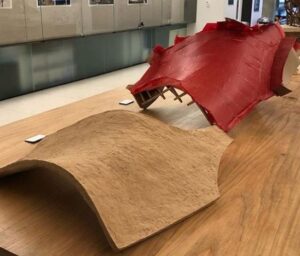
Source: Chris Barbalis on Unsplash
In the 2020s, architectural trends are all about sustainability. Industries in general are coming up with inventive techniques and materials to meet the growing global demand for a lower carbon footprint and a more sustainable lifestyle. Within architecture some of the innovations that are popping are within 3D printing construction and green building materials made from sustainable materials that create minimal waste and reduces a building’s energy consumption.
Wood architects and engineers are exploring different kinds of fabrication techniques to create novel materials that are lightweight, strong and easy to install, while generating nearly no waste during construction, and sometimes even incorporating waste itself into the construction.

Source: Fay Jones School on Instagram
The University of Arkansas Fay Jones School of Architecture and Design’s Future of Wood Studio has been encouraging students to experiment with fine wood particles like sawdust, wood flour, fillers and adhesives to engineer their own wood products. The products that were created with technologies like 3D printing and milling machines were then used to build architectural structures.
The strongest panels that were made during one invention process that focused on cast composites, was created by incorporating a two-part epoxy resin into a 80% wood flour mixture. This material was used to build a pavilion that was judged strong enough, and with a uniform appearance and physical integrity.

Source: Fay Jones School on Instagram
Another line of experimentation involved the students using a 3D printer, intended for printing ceramics, to print wood modules that were then draped over a frame pavilion. The final composition of the modules was 55% wood flour, epoxy resins, as well as flour, water and PVA glue.
 Even YouTube vloggers are joining in on creating new woodworking techniques. Chris Salome reinforced angled, tapered table legs with epoxy resins in order to increase their strength while adding an aesthetic touch.
Even YouTube vloggers are joining in on creating new woodworking techniques. Chris Salome reinforced angled, tapered table legs with epoxy resins in order to increase their strength while adding an aesthetic touch.
Epoxy resins are often added to many construction products in order to make them more energy efficient, durable, lessen maintenance needs, offer thermal insulation and increase the product life span.
Utilising wood flour made out of fabrication waste to create wood composites with epoxy resins is a remarkable example of sustainable architecture that illustrates how material science can create innovations that lowers construction’s carbon footprint.
Read more on epoxy resins in environmentally friendly construction here.